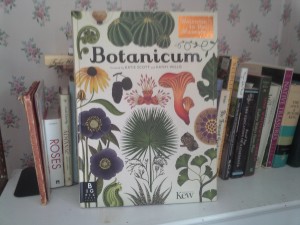
One of the great joys of gardening and writing about plants is amassing a collection of books. These days, you might argue that everything is available online, via e–books or other electronic means. That may be so, but it would be hard to find a substitute for Botanicum by illustrator, Katie Scott, and scientist, Kathy Willis, a book that was published last year under the auspices of the Royal Botanic Gardens at Kew. It is monumental in just about every way.
To begin with, the bountifully illustrated book is an impressive size—about 14.25 inches by 10.5 inches. It is printed in full color on the kind of heavy paper that is a rarity in the world of modern book publishing. But the content is the real revelation. The authors intend the work to be a museum in book form, cataloging the world’s plant groups and describing the history, appearance and reproductive habits of each group’s members, with botanical illustrations that show representatives of different plant types.
The whole work starts with a two-page tree of life that connects all plant groups to swirling, branching stems that wind all the way back to the simple algae that first arose about 3.8 billion years ago. Farther up the page, the main stem divides into angiosperms, the flowering plants that make up about 80 percent of all plant species, and gymnosperms, those plants, like conifers and gingkos, that bear exposed fruits. The branches multiply to include characteristic examples of every growing thing. The organization is straightforward; the simplest, oldest plants are at the bottom of the “tree” and the most recent, like carrots and hibiscus, are at the top.
As befits such a large book, the illustrations are bold and bright. The turkeytail fungus—Trametes versicolor—in the “Fungi and Lichens” section, for example, is both botanically correct and so artistically rendered that taken by itself, it might be mistaken for an abstract painting. The illustrator, Katie Scott, was inspired by late nineteenth and early twentieth century German botanical artist and polymath, Ernst Haeckel, whose colorful illustrations for his 1904 work, Kunstformen der Natur (Art Forms of Nature) are so full of life that they seem ready to dance off the page.
Representative plants may be depicted via illustrations of fruits, branches, flowers or stem cross sections. In some cases, like the pages illustrating “Environment: Carboniferous Forests” and “Environment: Rainforests”, an entire grouping of plants dominates a single page. Unlike some other botanical artists, Ms. Scott does not pair plants with their pollinators or insect pests. The unusual hawkmoth that is the sole pollinator of the Christmas star orchid—Angraecum sesquipedale—is the lone insect inhabitant of Botanicum.
In her text, Dr. Willis gives a wonderful sense of the great span of horticultural history and the ways in which plant groups evolved. She also includes tantalizing practical details, as in the passage on giant sequoias that mentions the 30 meter or 98 foot root run that the sequoia requires to anchor its great height firmly in the ground. She is equally good at describing natural processes, including the annual chain of events that ends in deciduous trees shedding their leaves as shorter daylight hours take hold in the fall.
Being a lover of flowers, I am especially taken with the illustration for “Environment: Alpine Plants”, which shows a rock pile abloom with primulas, saxifrages and gentians, all under a rounded sky that looks like a Victorian glass dome. The picture perfectly illuminates the idea of an ecosystem as a blooming world in miniature.
The exhaustive treatment of the plant kingdom also includes important food crops, lest we forget that staples like rice, corn and various forms of wheat evolved along with all other plants. Now, those three grasses—for that is what they are–account for over 50 percent of the world’s food.
As an adult, I am enchanted with Botanicum, but I can see it having equal, if not more value as a teaching tool for children. The illustrations all by themselves would fascinate some children and tales, such as that of the sponge gourd or loofah, which is both edible and useful for bathing, would pique interest. I can easily imagine Botanicum, as the vehicle that launches a thousand questions from curious kids.
The authors share that sense of wonder and they conclude the book with an inspiring thought:
“The journey goes on. Not only are scientists continuing to discover new plant species every year (almost every day), but plants are continuing to evolve in response to changing conditions and new challenges. The story has just begun.”
